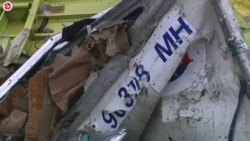On Feb. 18, Russian presidential spokesman Dmitry Peskov commented on the publication of leaked Dutch intelligence documents concerning the July 2014 shoot-down of Malaysia Airlines Flight MH17. He claimed the international Joint Investigation Team (JIT) investigation into the incident, which killed 298, was “biased” and that the leaks proved Russia’s criticism of investigators’ methods was correct. In fact, nothing in the documents contradicts the JIT’s findings on MH17.
The documents were published on a website called Bonanza Media run by Max van der Werff, a Dutch national who has visited the Russian-controlled parts of Ukraine's contested Donbas area several times. Van der Werff has produced material attempting to shift blame for the airliner’s crash away from Russia. Van der Werff shot a documentary on the subject with the help of Yana Yerlashova, formerly with Russia's state-owned media outlet RT (Russia Today).
The leaked documents relate to the Dutch intelligence service’s accounting of Buk M1 surface-to-air missile (SAM) systems in Ukraine and Russia around the time of the MH17 crash. Since both the Russian and Ukrainian armed forces use the Buk, Dutch intelligence was reportedly able to determine the location of missile systems for both sides and, according to the documents, found that no Buk M1s were in the area where MH17 was shot down.
At first glance, that would appear to raise questions about what really downed the airliner. A review of the record shows it’s not that simple.
According to the Dutch intelligence documents, the Russian Buk M1 SAM systems that were closest to the MH17 crash site belonged to the 53rd Air Defense Missile Brigade, which at the time was deployed in Russia’s Rostov oblast, on the border with Ukraine. The fact that the unit was based in Russia might seem to rule out Russian involvement in the destruction of MH17.
However, JIT investigators found evidence that a Buk M1 system from this unit had crossed into Ukraine and was transported back into Russia after shooting down the airliner on July 17, 2014.
Moreover, the JIT found evidence specifically showing that the plane was downed by a Buk surface-to-air missile system, such as distinctive metal fragments found in the downed plane’s debris and the bodies of passengers, as well as fragments of a BUK missile itself.
Peskov and Van der Werff appear to imply that if no BUKs were in the area of the shoot-down, a BUK could not have been involved. While that fails to explain the presence of Buk fragments and debris, it also contradicts several explanations Russia has offered in the past, including the idea that a Ukrainian Buk or military jet was responsible.
Russian officials and state media have categorically denied Russian involvement in the disaster, which killed all 283 passengers and 15 crew on board the Malaysian airliner.
Polygraph.info has published several fact-checks on alternative Russian explanations for the disaster. For example, in March 2019, the Russian state-owned outlet Sputnik published an article citing a Russian Foreign Ministry statement that attributed the crash to a Buk missile. In 2018, the Russian Defense Ministry’s official TV channel TV Zvezda produced a report that included an “eyewitness” who claimed a Ukrainian Buk system was responsible.







